Overall likelihood of approval (LOA) for new assets entering Phase I was 6.7% in 2023, down from 7.9% three years before. The latest 10-year dataset from Biomedtracker contains 10,954 separate drug-indication development programs, which is the largest sample yet as industry pipelines have continued to grow. This expansion in the pipeline has been necessary to accommodate increasing attrition.
As shown in Exhibit 1, Phase II remains the greatest hurdle with just a 28% probability of success, although the success rates at Phase I and III are also lower than previous analyses.
Overtime, the analysis shows that biopharma companies have stopped more assets in the earlier stages of development.
Success rates can be segmented in rolling time periods to judge how pharmaceutical companies have changed their approach to the various stage gates. The largest difference was seen in Phase I, where a success rate of over 75% during 2006-2008 has now dropped to below 40%. Whereas previously Phase I was considered to be a safety hurdle among healthy volunteers, drug companies are increasingly enrolling patients and evaluating efficacy surrogates. This allows for programs that are less likely to result in meaningful patient outcomes to be identified and discontinued at an early stage, thus avoiding the expense of larger trials.
Despite stricter criteria for go/no-go decisions at Phase I, Phase II and Phase III success rates have also declined, albeit not to the same extent. Phase II remains the largest hurdle for drug development and it is often appropriate for this to be the stage when a program can be halted with confidence.
It is worrying that Phase III success rates have dipped in recent years. Failures at this stage are the most expensive and catastrophic for R&D productivity measures. This will need to be carefully monitored as it is possible that Phase III success rates below 50% are not sustainable for long-term R&D investments.
A Look At Therapy Area Trends
Success rates are widely variable depending on the therapy area and disease under evaluation. Confidence in disease biology, validated clinical endpoints and trial designs, the competitive landscape, and regulatory pathways are all unique to each indication, and so it makes sense to apply disease-specific benchmarks for LOAs. Exhibit 2 shows the fourfold spread from the disease area with the highest success rates (hematology: 19.1%) down to the lowest (respiratory: 4.5%).
It is well established that an increasing proportion of drug development programs are targeted against oncology. With just a 4.7% likelihood of approval for new drugs in Phase I, the overall weighting of oncology within the broader industry is certainly dragging down trends. Furthermore, the competitive intensity in oncology itself will result in greater levels of attrition.
What Does It All Mean?
It is perhaps inevitable that success rates decline over time as a natural consequence of “picking the low-hanging fruit first” – a common analogy for drug development. That leaves innovators with more complex drug targets to work with and a plethora of approved drug options that raise the barrier for viable new therapies.
Nevertheless, optimists can point towards advances in our fundamental understanding of biology, chemistry and data science that should unlock large untapped reserves of new drug potential. Certainly, drug development has become much more sophisticated with greater use of precision therapeutics, biomarkers, digital health and regulatory innovation that all allow for greater R&D efficiency and raised success rates.
There is a school of thought that suggests optimization around LOA can come at the expense of risk-taking and patient benefit. If all drug programs were designed to be successful, then we would only ever develop “me-too” drugs. Perhaps declining LOA should be embraced as a signal that biopharmaceutical companies are willing to take and invest in riskier bets, providing new treatment options for diseases such as obesity, Alzheimer’s disease and non-alcoholic steatohepatitis (NASH). These are all indications where success rates are extremely unflattering and poor benchmarks have stifled investment.
The ideal R&D strategy is one that identifies therapeutic and market potential as early as possible, allowing uncompetitive assets to be deprioritized. Risk should always be embraced, and early clinical development should be seen not just as a regulatory necessity but also to allocate precious later-stage resources as efficiently as possible. Just as each new drug approval is toasted, each effective early stage discontinuation should be heralded as a sign of progress.







